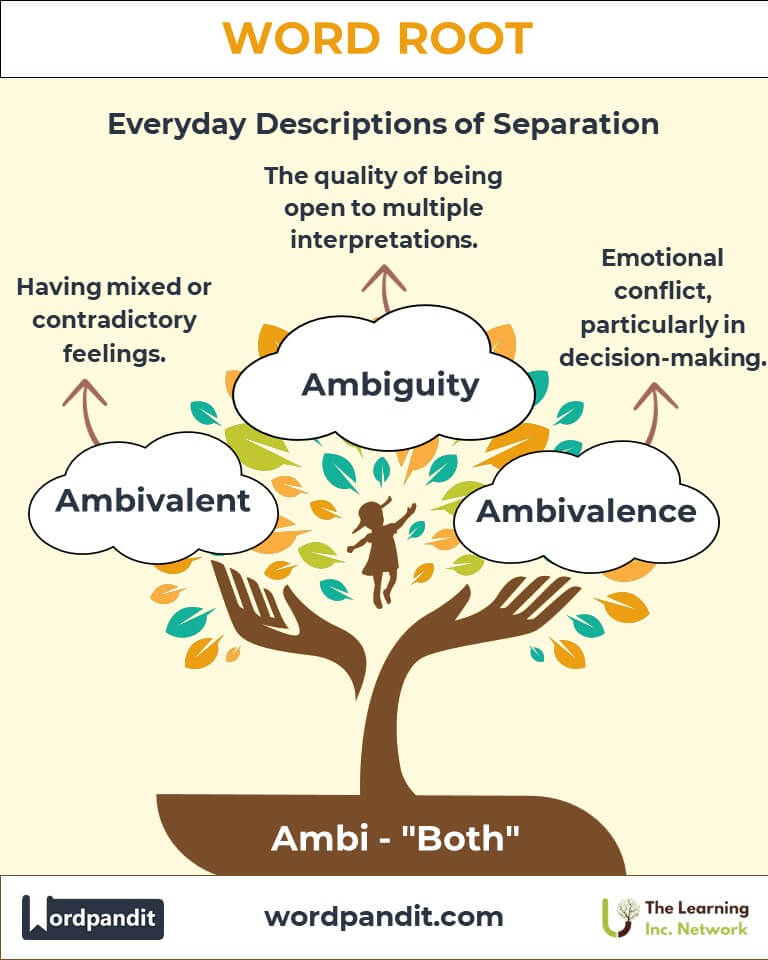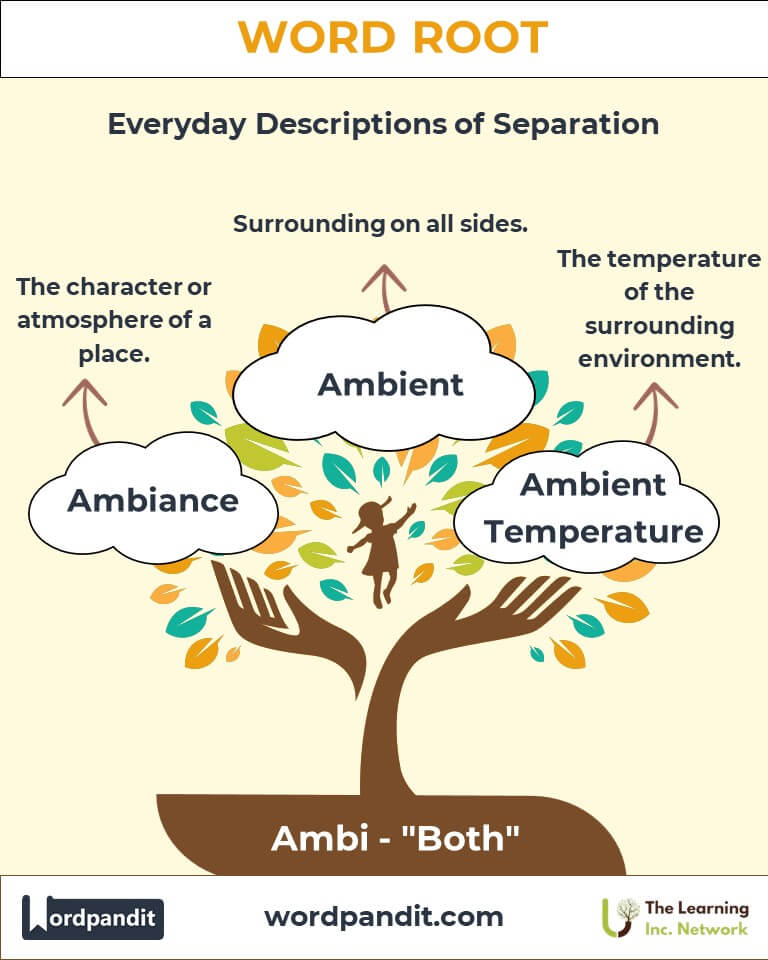Ambi: Exploring Duality and Versatility in Language
Discover the multifaceted nature of the word root "ambi," derived from Latin, meaning "both." From "ambidextrous" to "ambient," this root enriches our vocabulary by emphasizing duality, adaptability, and presence in various contexts.

Table of Contents
- Introduction: The Dual Nature of Ambi
- Etymology and Historical Journey
- Mnemonic: Unlocking the Power of Ambi
- Common Ambi-Related Terms
- Ambi Through Time
- Ambi in Specialized Fields
- Illustrative Story: Ambi in Action
- Cultural Significance of Ambi
- The Ambi Family Tree
- FAQs about the Ambi Root
- Test Your Knowledge: Ambi Mastery Quiz
- Conclusion: The Living Legacy of Ambi
Introduction: The Dual Nature of Ambi
Imagine having equal skill in both hands or being surrounded by a calming presence on all sides. The root "ambi," pronounced am-bee, encapsulates such versatility and duality. From "ambidextrous" (equally skilled with both hands) to "ambient" (surrounding on all sides), "ambi" illustrates balance and adaptability, highlighting its importance in language, science, and daily life.

Etymology and Historical Journey
The root "ambi" originates from the Latin word ambi, meaning "on both sides" or "around." This versatile prefix entered English via Old French and Middle English. Historically, it has been a linguistic marker for concepts that embody duality or omnipresence, such as ambivalence (mixed feelings) or ambiance (the surrounding environment).
Mnemonic: Unlocking the Power of Ambi
To remember "ambi," think of a figure standing with arms outstretched, equally adept at holding objects in both hands, symbolizing balance and dual presence.
Mnemonic Device: "Ambi stands for both—left, right, and all around!"
Common Ambi-Related Terms
- Ambidextrous (am-bi-dek-struhs):
Definition: Equally skilled with both hands.
Example: "The ambidextrous artist painted with both hands simultaneously."
- Ambivalent (am-biv-uh-lent):
Definition: Having mixed or contradictory feelings about something.
Example: "She felt ambivalent about moving to a new city—excited yet anxious."
- Ambiance (am-bee-ahns):
Definition: The character or atmosphere of a place.
Example: "The cozy ambiance of the café made it a favorite spot for writing."
- Ambient (am-bee-uhnt):
Definition: Surrounding on all sides.
Example: "The ambient lighting in the room created a soothing effect."
- Ambiguity (am-bi-gyoo-i-tee):
Definition: The quality of being open to multiple interpretations.
Example: "The ambiguity of his statement led to confusion."
Ambi Through Time
- Ambivalent: First coined in the early 20th century in psychology to describe conflicting emotions, its use has expanded to broader contexts.
- Ambient: Originally used in meteorology to describe surrounding conditions, it is now widely applied in art, design, and technology.
Ambi in Specialized Fields
- Psychology:
Ambivalence: Describes emotional conflict, particularly in decision-making.
Application: Understanding ambivalence aids in therapy and emotional regulation.
- Technology:
Ambient computing: Refers to systems that operate seamlessly in the background of daily life.
Example: Smart homes use ambient technologies for convenience and efficiency.
- Music and Art:
Ambient music: A genre focused on creating atmospheric soundscapes.
Impact: Used in relaxation and therapeutic settings.
- Environmental Studies:
Ambient temperature: Refers to the temperature of the surrounding environment.
Relevance: Critical in climate studies and engineering.
Illustrative Story: Ambi in Action
Ella, a software engineer, often grappled with ambivalence in her decision-making process. Torn between two promising projects, she sought clarity by meditating in the calming ambiance of a nearby park. There, ambient sounds of chirping birds and rustling leaves eased her mind, allowing her to embrace the duality of her choices and move forward with confidence.
Cultural Significance of Ambi
The root "ambi" resonates across cultures, symbolizing balance and inclusivity. In philosophy, duality is a recurring theme, whether in Eastern concepts like yin and yang or Western dialectics. The word "ambivalence" captures the complexity of human emotions, while "ambiance" reflects our desire for harmonious surroundings.

The Ambi Family Tree
Explore related roots and terms:
- Bi- (Two):
Binary: Comprising two parts.
- Omni- (All):
Omnipresent: Present everywhere.
- Circum- (Around):
Circumference: The distance around a circle.

FAQs About the "Ambi" Root
Q: What does "ambi" mean, and where does it come from?
A: The root "ambi" means "both" or "around." It originates from the Latin word ambi, which carries the same meaning. Over time, it entered the English language through Old French and Middle English, enriching the vocabulary with terms that highlight duality, balance, and omnipresence.
Q: How does "ambidextrous" reflect the meaning of "ambi"?
A: "Ambidextrous" combines ambi (both) and dexter (right hand) to mean "skilled with both hands." This term emphasizes balance and equal proficiency, showcasing the versatility that "ambi" implies.
Q: What is the connection between "ambivalent" and human emotions?
A: "Ambivalent" derives from ambi (both) and valent (strength or value), signifying conflicting feelings or attitudes about a single issue. It doesn't imply confusion but rather the coexistence of opposing emotions, such as love and hate, highlighting the complexity of human experiences.
Q: What is the significance of "ambient" in technology and design?
A: "Ambient," meaning surrounding or encompassing, is vital in fields like technology and interior design. For example, "ambient computing" refers to systems that seamlessly integrate into the environment, and "ambient lighting" creates a mood by blending into the surroundings without being intrusive.
Q: Why does "ambiguity" signify uncertainty or multiple meanings?
A: "Ambiguity" combines ambi (both) and agere (to drive or act), referring to a situation with more than one interpretation. This concept captures the root's essence of duality, illustrating the challenge of navigating unclear or multiple possibilities in communication.
Q: Are "ambi" and "omni" interchangeable?
A: No, "ambi" means "both" or "around," focusing on duality or surrounding presence. In contrast, "omni" means "all" or "everywhere," signifying universality. For example, "ambidextrous" refers to using both hands, while "omnipresent" means existing everywhere.
Q: How does "ambiance" reflect the essence of "ambi"?
A: "Ambiance" refers to the surrounding atmosphere or mood of a space. Rooted in ambi, it conveys the idea of an encompassing presence, whether it’s the soothing ambiance of a quiet library or the energetic ambiance of a lively café.
Test Your Knowledge: Ambi Mastery Quiz
1. What does "ambi" mean?
2. Which term describes the surrounding atmosphere?
3. What does "ambidextrous" signify?
4. What is the primary focus of ambient computing?
5. Which word describes mixed emotions?
Conclusion: The Living Legacy of Ambi
The root "ambi" celebrates duality, inclusivity, and omnipresence, enriching language across fields and cultures. From describing human emotions to defining technological advancements, its relevance continues to grow. As we embrace the "ambi" perspective, we honor the beauty of balance and adaptability in a multifaceted world.













Supperrr dictionary